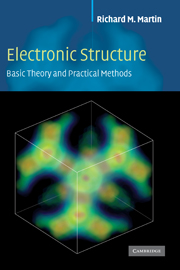Book contents
- Frontmatter
- Contents
- Preface
- Acknowledgments
- Notation
- Part I Overview and background topics
- Part II Density functional theory
- Part III Important preliminaries on atoms
- Part IV Determination of electronic structure: the three basic methods
- 12 Plane waves and grids: basics
- 13 Plane waves and grids: full calculations
- 14 Localized orbitals: tight-binding
- 15 Localized orbitals: full calculations
- 16 Augmented functions: APW, KKR, MTO
- 17 Augmented functions: linear methods
- Part V Predicting properties of matter from electronic structure – recent developments
- Appendix A Functional equations
- Appendix B LSDA and GGA functionals
- Appendix C Adiabatic approximation
- Appendix D Response functions and Green's functions
- Appendix E Dielectric functions and optical properties
- Appendix F Coulomb interactions in extended systems
- Appendix G Stress from electronic structure
- Appendix H Energy and stress densities
- Appendix I Alternative force expressions
- Appendix J Scattering and phase shifts
- Appendix K Useful relations and formulas
- Appendix L Numerical methods
- Appendix M Iterative methods in electronic structure
- Appendix N Code for empirical pseudopotential and tight-binding
- Appendix O Units and conversion factors
- References
- Index
14 - Localized orbitals: tight-binding
from Part IV - Determination of electronic structure: the three basic methods
Published online by Cambridge University Press: 05 June 2012
- Frontmatter
- Contents
- Preface
- Acknowledgments
- Notation
- Part I Overview and background topics
- Part II Density functional theory
- Part III Important preliminaries on atoms
- Part IV Determination of electronic structure: the three basic methods
- 12 Plane waves and grids: basics
- 13 Plane waves and grids: full calculations
- 14 Localized orbitals: tight-binding
- 15 Localized orbitals: full calculations
- 16 Augmented functions: APW, KKR, MTO
- 17 Augmented functions: linear methods
- Part V Predicting properties of matter from electronic structure – recent developments
- Appendix A Functional equations
- Appendix B LSDA and GGA functionals
- Appendix C Adiabatic approximation
- Appendix D Response functions and Green's functions
- Appendix E Dielectric functions and optical properties
- Appendix F Coulomb interactions in extended systems
- Appendix G Stress from electronic structure
- Appendix H Energy and stress densities
- Appendix I Alternative force expressions
- Appendix J Scattering and phase shifts
- Appendix K Useful relations and formulas
- Appendix L Numerical methods
- Appendix M Iterative methods in electronic structure
- Appendix N Code for empirical pseudopotential and tight-binding
- Appendix O Units and conversion factors
- References
- Index
Summary
Summary
Localized functions afford a satisfying description of electronic structure and bonding in an intuitive localized picture. They are widely used in chemistry and have been revived in recent years in physics for efficiency in large simulations, especially “order-N” methods (Ch. 23). The semi-empirical tight-binding method is particularly simple and instructive since the basis is not explicitly specified and one needs only the matrix elements of the overlap and the hamiltonian. This chapter starts with a definition of the problem of electronic structure in terms of localized orbitals, and considers various illustrative examples in the tight-binding approach. Many of the concepts and forms carry over to full calculations with localized functions that are the subject of the following chapter, Ch. 15.
The hallmark of the approaches considered in this chapter and the next is that the wavefunction is expanded in a linear combination of fixed energy-independent orbitals, each associated with a specific atom in the molecule or crystal. For example, the linear combination of atomic orbitals (LCAO) formulation denotes a basis of atomic or modified atomic-like functions. Such a basis provides a natural, physically motivated description of electronic states in materials; in fact, possibly the first theory of electrons in a crystal was the tight-binding method developed by Bloch [36] in 1928. The history of this approach is summarized nicely by Slater and Koster [589], who point out that the seminal work of Bloch considered only the simplest s-symmetry function and the first to consider a basis of different atomic orbitals were Jones, Mott, and Skinner [594] in 1934.
Information
- Type
- Chapter
- Information
- Electronic StructureBasic Theory and Practical Methods, pp. 272 - 297Publisher: Cambridge University PressPrint publication year: 2004
